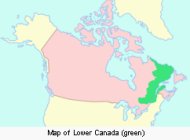
Worksheets and No Prep Teaching Resources
Reading Comprehension Worksheets
 Worksheets and No Prep Teaching Resources Reading Comprehension Worksheets |
|
| edHelper's suggested reading level: | grades 6 to 7 | |
| Flesch-Kincaid grade level: | 7.08 |
|
Lower Canada
By Mary Lynn Bushong |

|
 1 Five hundred years after the Vikings came to Canada, fishermen from France discovered the Grand Banks. They found a wealth of fish, like cod. Then they discovered the furs offered for trade by the native people.
1 Five hundred years after the Vikings came to Canada, fishermen from France discovered the Grand Banks. They found a wealth of fish, like cod. Then they discovered the furs offered for trade by the native people. |
Create Weekly Reading Books
Prepare for an entire week at once! |
| Leave your feedback on Lower Canada (use this link if you found an error in the story) |